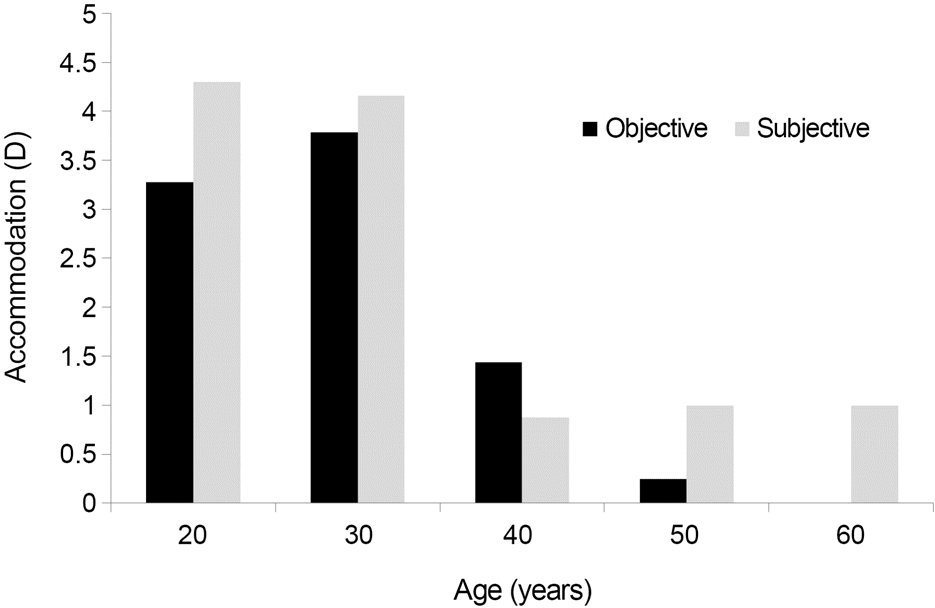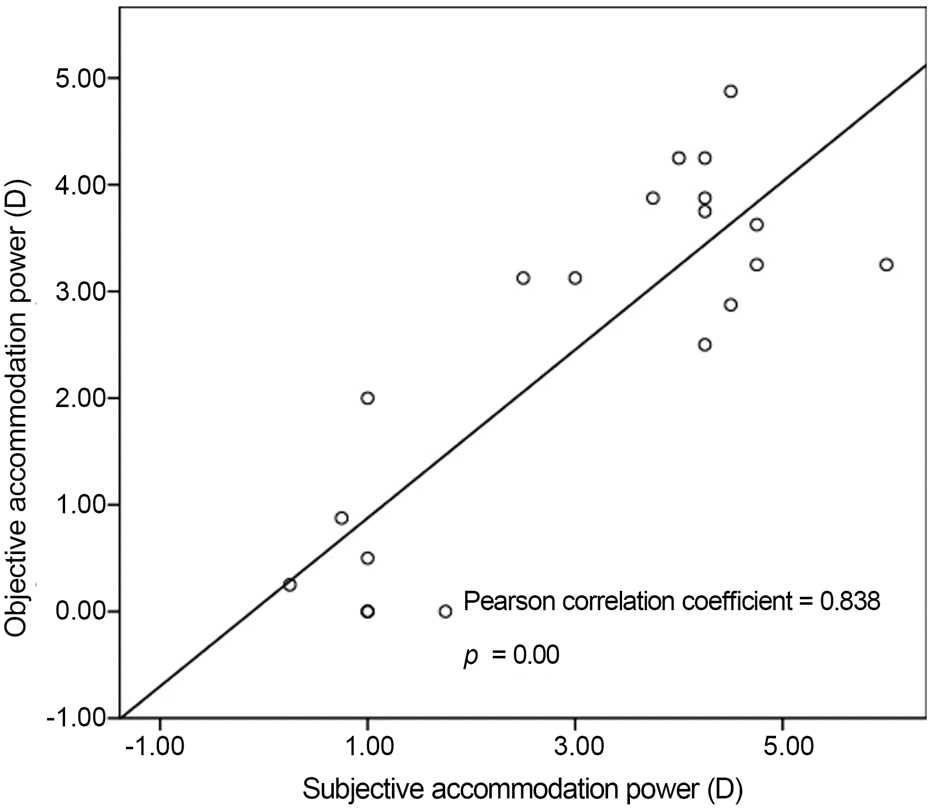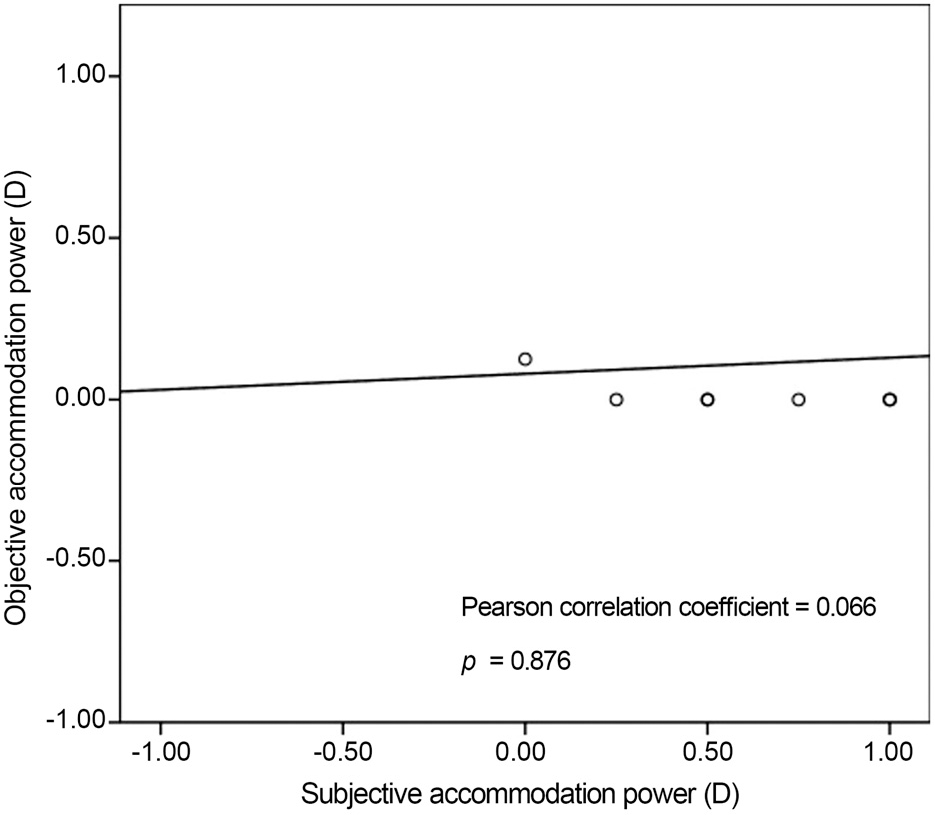Abstract
Purpose
To evaluate the objective amplitude of accommodation in various age groups using an autorefractometer and to com-pare the results with subjective assessments on accommodation. Objective accommodative amplitude of artificial lenses in post-operative cataract patients was also measured.
Methods
In this study, 41 patients who visited Korea University Guro Hospital from July through August 2014 were categorized into 6 different age groups. Accommodative amplitude was measured using long-distance refraction at 5 m and short-distance refraction at 20 cm. In 20 patients, subjective amplitude of accommodation was measured using the minus lens technique and was compared with the measured objective accommodative amplitude. Accommodative amplitude was also measured in 8 pa-tients who received cataract surgery.
Results
The mean accommodative ability in normal people was 2.38 D. The age groups of 10-19, 20-29, 30-39, 40-49, 50-59, and over 60 years showed accommodative amplitudes of 3.31 ± 0.99 D, 3.25 ± 0.34 D, 3.78 ± 0.68 D, 1.00 ± 0.60 D, 0.22 ± 0.23 D, 0.00 ± 0.00 D, respectively. The results showed a rapid decrease in accommodative ability of patients older than 40 years and demonstrated a correlation between objective and subjective amplitude of accommodation (Pearson’s correlation coefficient 0.838). There was a significant difference between objective and subjective accommodative amplitudes in artificial lenses ( p = 0.015), with average objective and subjective measures of 0.10 ± 0.23 D and 0.59 ± 0.35 D, respectively.
Go to : 
References
1. Michaels DD. Visual Optics and Refraction. 1st. St. Louis: The C.V;Mosby company. 1975. p. 268–81.

3. Sugitami Y, Komori T, Kitoh R, Hayano S. Apparent accom-modation (pseudo-accommodation) on pseudophakia. Folia Ophthalmol Jpn. 1979; 30:326–31.
4. Huber C. Planned myopic astigmatism as a substitute for accom-modation in pseudophakia. J Am Intraocul Implant Soc. 1981; 7:244–9.

5. Nakazawa M, Ohtsuki K. Apparent accommodation in pseudo-phakic eyes after implantation of posterior chamber intraocular lenses: optical analysis. Invest Ophthalmol Vis Sci. 1984; 25:1458–60.
6. Ravalico G, Baccara F. Apparent accommodation in pseudophakic eyes. Acta Ophthalmol (Copenh). 1990; 68:604–6.

7. Duane A. Are the current theories of accommodation correct? Am J Ophthalmol. 1925; 8:196–202.
8. Kabayama T, Fuseya Y, Miyazaki H. A quasi-static study of ac-commodation with aging in normal cases. Nihon Ganka Gakkai Zasshi. 1987; 91:494–7.
9. Kim BC. The normal value of amplitude of accommodation in Koreans. J Korean Ophthalmol Soc. 1979; 20:153–7.
10. Sheppard AL, Davies LN. Clinical evaluation of the Grand Seiko Auto Ref/Keratometer WAM-5500. Ophthalmic Physiol Opt. 2010; 30:143–51.

11. Win-Hall DM, Glasser A. Objective accommodation measurements in prepresbyopic eyes using an autorefractor and an aberrometer. J Cataract Refract Surg. 2008; 34:774–84.

12. Win-Hall DM, Glasser A. Objective accommodation measure-ments in pseudophakic subjects using an autorefractor and an aberrometer. J Cataract Refract Surg. 2009; 35:282–90.

Go to : 




 PDF
PDF ePub
ePub Citation
Citation Print
Print






 XML Download
XML Download